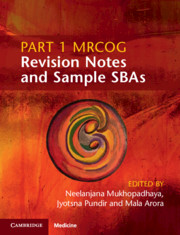Book contents
- Part 1 MRCOG Revision Notes and Sample SBAs
- Part 1 MRCOG Revision Notes and Sample SBAs
- Copyright page
- Dedication
- Contents
- Contributors
- Introduction
- Section 1 Anatomy
- Section 2 Embryology
- Section 3 Physiology
- Section 4 Genetics
- Section 5 Endocrinology
- Section 6 Biochemistry
- Section 7 Pathology
- Chapter 38 Pathology of Clinical Sepsis
- Chapter 39 Histopathology of Female Organs, Including Pituitary and Hypothalamus
- Chapter 40 Placental Site Implantation
- Chapter 41 Teratogenesis
- Chapter 42 Pathological Conditions Related to the Uterus, Tubes and Ovaries
- Chapter 43 Gynaecological Cancers
- Chapter 44 Pathophysiology of Pain
- Chapter 45 Pathology of the Bladder, Urethra and Vagina
- Section 8 Clinical Management and Data Interpretation
- Section 9 Pharmacology
- Section 10 Microbiology
- Section 11 Immunology
- Section 12 Biophysics
- Section 13 Epidemiology and Statistics
- Appendices:Practice Question Papers with Answers
- Index
Chapter 40 - Placental Site Implantation
from Section 7 - Pathology
Published online by Cambridge University Press: 24 November 2020
- Part 1 MRCOG Revision Notes and Sample SBAs
- Part 1 MRCOG Revision Notes and Sample SBAs
- Copyright page
- Dedication
- Contents
- Contributors
- Introduction
- Section 1 Anatomy
- Section 2 Embryology
- Section 3 Physiology
- Section 4 Genetics
- Section 5 Endocrinology
- Section 6 Biochemistry
- Section 7 Pathology
- Chapter 38 Pathology of Clinical Sepsis
- Chapter 39 Histopathology of Female Organs, Including Pituitary and Hypothalamus
- Chapter 40 Placental Site Implantation
- Chapter 41 Teratogenesis
- Chapter 42 Pathological Conditions Related to the Uterus, Tubes and Ovaries
- Chapter 43 Gynaecological Cancers
- Chapter 44 Pathophysiology of Pain
- Chapter 45 Pathology of the Bladder, Urethra and Vagina
- Section 8 Clinical Management and Data Interpretation
- Section 9 Pharmacology
- Section 10 Microbiology
- Section 11 Immunology
- Section 12 Biophysics
- Section 13 Epidemiology and Statistics
- Appendices:Practice Question Papers with Answers
- Index
Summary
The placenta is the organ that anchors the developing fetus to the uterine wall for providing nutrients and waste removal of the fetus. Normal placenta has a single chorionic plate and a fetal decidual portion. Under normal circumstances, it is implanted on the posterior wall in the upper part of the body of the uterus. On implantation of the blastocyst into the endometrium, the outer layer of the blastocyst forms the trophoblast. This trophoblastic layer differentiates into the outer syncytiotrophoblast layer and inner cytotrophoblastic layer. The cytotrophoblast is a cuboidal cell, which forms the syncytiotrophoblast, and the intermediate trophoblast. The syncytiotrophoblast is a multinucleated giant cell structure, which secretes human chorionic gonadotropin (hCG). The intermediate trophoblast anchors the placenta to the decidua and myometrium, replaces the spiral arteries of basal plate and helps establish the foeto-maternal circulation.
- Type
- Chapter
- Information
- Part 1 MRCOG Revision Notes and Sample SBAs , pp. 262 - 264Publisher: Cambridge University PressPrint publication year: 2020



